Allenby Formation
The Allenby formation is a sedimentary rock formation deposited during the early to early Middle Eocene.[2] It consists of conglomerates, sandstones with interbedded with shales and coal. The coal seams contain an abundance of insect, fish and plant fossils, known from the shales since 1877[3][4][5] but best known from the Princeton Chert.[1]
| Allenby Formation Stratigraphic range: Ypresian 52.5–48 Ma | |
|---|---|
| Type | Geological formation |
| Unit of | Princeton Group |
| Sub-units | Princeton Chert, Vermillion Bluffs Shale |
| Area | 300 km2 (120 sq mi)[1] |
| Thickness | 1,860–2,100 m (6,100–6,890 ft)[1] |
| Lithology | |
| Primary | Shale, sandstone |
| Other | Coal–breccia, coal–chert |
| Location | |
| Coordinates | 49°22.6′N 120°32.8′W |
| Approximate paleocoordinates | 53.1°N 107.5°W |
| Region | British Columbia |
| Country | |
| Extent | Princeton Basin |
| Type section | |
| Named for | Allenby, British Columbia |
| Named by | Shaw |
| Year defined | 1952 |
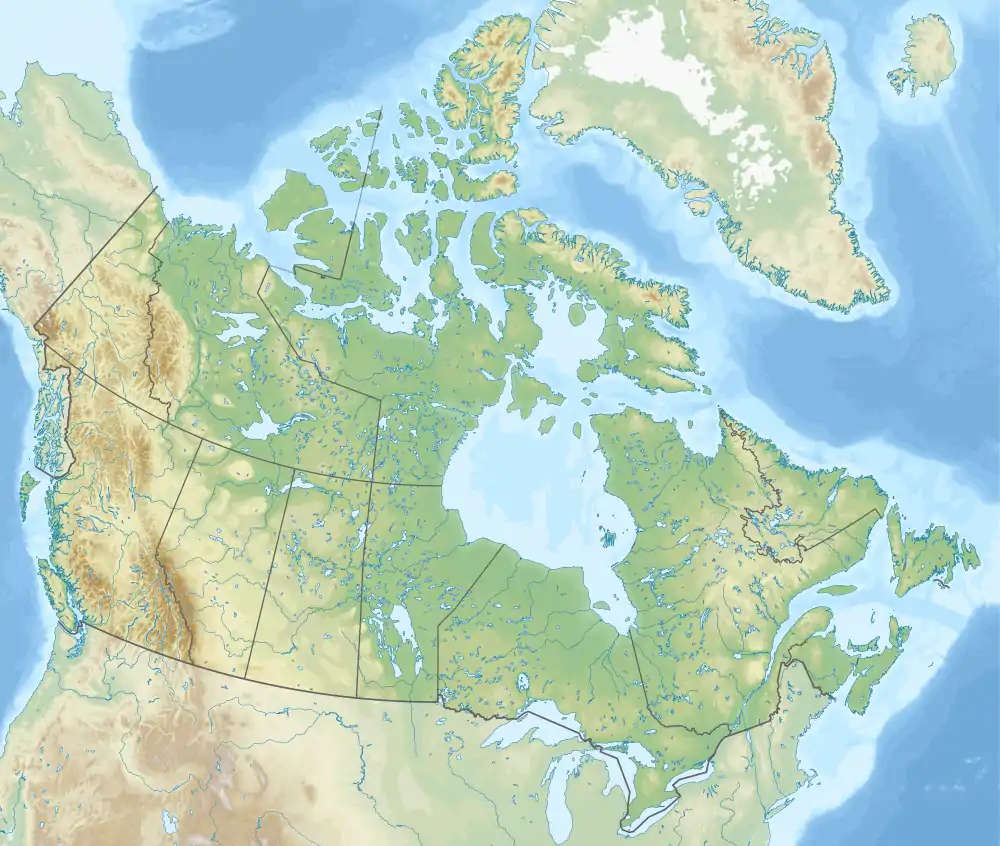 Allenby Formation (Canada)  Allenby Formation (British Columbia) | |
Fossil content
The following fossil genera and species have been described from the Allenby Formation:
Conifers, ferns, and ginkgos
| Name | Authority | Year | Family | Notes | Images |
|---|---|---|---|---|---|
|
Shorn & Wehr, 1986 |
2013 |
Oldest true fir described |
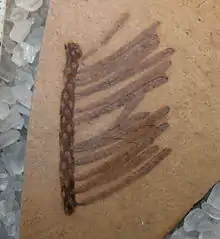 | ||
|
Arnold, 1955 |
1955 |
 | |||
|
2002 |
A ginkgo |
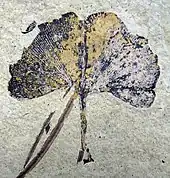 | |||
|
Mustoe, 2002 |
2002 |
A ginkgo |
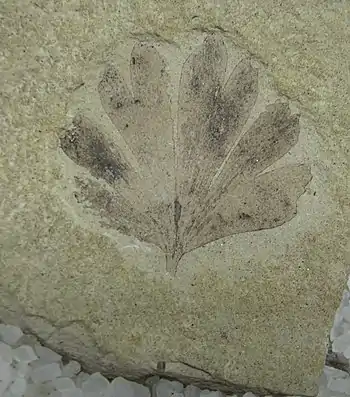 | ||
|
1951 |
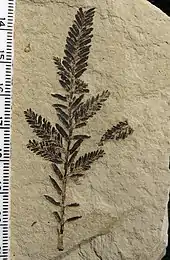 | ||||
Flowering plants
| Name | Authority | Year | Family | Notes | Images |
|---|---|---|---|---|---|
|
Wolfe & Tanai |
1987 |
A maple |
|||
|
Wolfe & Tanai |
1987 |
A maple |
|||
|
Wolfe & Tanai |
1987 |
A maple |
|||
|
Wolfe & Tanai |
1987 |
A maple |
|||
|
Alnus parvifolia[4] |
(Berry) Wolfe & Wehr |
2013 |
An Alder |
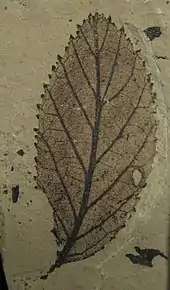 | |
|
Wolfe & Wehr |
1987 |
A birch |
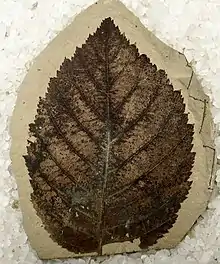 | ||
|
Fagopsis undulata[10] |
(Knowlton) Wolfe & Wehr |
2013 |
A beech |
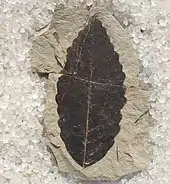 | |
|
Fothergilla dunthornei[11] |
Radtke, Pigg, & Wehr |
2005 |
Hamamelidaceae |
||
|
DeVore, Moore, Pigg, & Wehr |
2004 |
A snow wreath |
|||
|
Bogner, Johnson, Kvaček & Upchurch |
2007 |
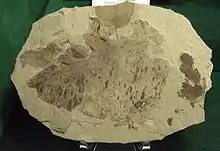 | |||
|
Palaeocarpinus stonebergae[14] |
Pigg, Manchester, & Wehr |
2003 |
A betulaceous genus |
||
|
Berry |
2013 |
A laural genus |
 | ||
|
1988 |
A Sorbarieae genus |
||||
|
Pigg et al |
2007 |
A Tetracentron relative |
 | ||
|
Wolfe & Wehr |
2013 |
A dove-tree relative |
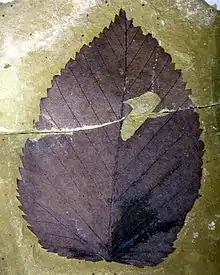 | ||
|
Denk & Dillhoff |
2007 |
An elm |
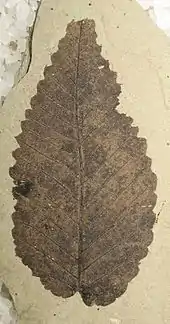 | ||
Animals
| Name | Authority | Year | Family | Notes | Images |
|---|---|---|---|---|---|
|
Scudder, 1895[18] |
1895 |
||||
|
Scudder, 1879[19] |
1879 |
||||
|
Cercopis grandescens |
Scudder, 1895[18] |
1895 |
|||
|
Cercopites torpescens |
Scudder, 1895[18] |
1895 |
|||
|
Coelidia columbiana |
Scudder, 1879[19] |
1879 |
|||
|
Cryptocephalites punctatus |
Scudder, 1895[18] |
1895 |
|||
|
Dawsonites veter |
Scudder, 1895[18] |
1895 |
|||
|
Archibald, 2005 |
2005 |
||||
|
Elaterites sp. |
Scudder, 1895[18] |
1895 |
|||
|
Enchophora sp. |
Scudder, 1895[18] |
1895 |
|||
|
Eomerope simpkinsae[21] |
Archibald & Rasnitsyn, 2018 |
2018 |
|||
|
Rice, 1968 |
1968 |
A sawfly |
|||
|
Wilson, 1977 |
1977 |
A percopsiform fish |
|||
|
Limonius impunctus |
Scudder, 1895[18] |
1895 |
|||
|
Palaeoptysma venosa |
Scudder, 1895[18] |
1895 |
|||
|
Palaphrodes sp. |
Scudder, 1895[18] |
1895 |
|||
|
Palecphora sp. |
Scudder, 1895[18] |
1895 |
|||
|
Planophlebia gigantea |
Scudder, 1879[19] |
1879 |
|||
|
Plecia canadensis |
Rice, 1959[24] |
1959 |
A marchfly |
||
|
Plecia pictipennis |
Rice, 1959[24] |
1959 |
A marchfly |
||
|
Plecia pulchra |
Rice, 1959[24] |
1959 |
A marchfly |
||
|
Plecia reducta |
Rice, 1959[24] |
1959 |
A marchfly |
||
|
Plecia transitoria |
Rice, 1959[24] |
1959 |
A marchfly |
||
|
Plecia similkameena |
Scudder, 1879[19] |
1879 |
A marchfly |
||
|
Rice, 1968 |
1968 |
A sawfly |
|||
|
Ptysmaphora fletcheri |
Scudder, 1895[18] |
1895 |
|||
|
Ricaniella antiquata |
Scudder, 1895[18] |
1895 |
|||
|
Stenecphora punctulata |
Scudder, 1895[18] |
1895 |
|||
|
Stenolocris venosa |
Scudder, 1895[18] |
1895 |
|||
|
Eberle, 2017 |
1935 |
Esthonychidae |
A tillodontia species |
||
References
- Mustoe, G.E. (1 January 2011). "Cyclic sedimentation in the Eocene Allenby Formation of south-central British Columbia and the origin of the Princeton Chert fossil beds". Canadian Journal of Earth Sciences. 48 (1): 25–43. doi:10.1139/E10-085.
- Allenby Formation at Fossilworks.org
- Penhallow, D.P. 1908. A report on Tertiary plants of British Columbia, collected by Lawrence M. Lambe in 1906 together with a discussion of previously recorded Tertiary floras. Canada Department of Mines, Geological Survey Branch, No. 1013. pp. 1–167.
- Dillhoff, R.M.; Dillhoff, T.A.; Greenwood, D.R.; DeVore, M.L.; Pigg, K.B. (2013). "The Eocene Thomas Ranch flora, Allenby Formation, Princeton, British Columbia, Canada". Botany. 91 (8): 514–529. doi:10.1139/cjb-2012-0313.
- Greenwood, D.R.; Pigg, K.B.; Basinger, J.F.; DeVore, M.L. (2016). "A review of paleobotanical studies of the Early Eocene Okanagan (Okanogan) Highlands floras of British Columbia, Canada, and Washington, U.S.A." Canadian Journal of Earth Sciences. 53 (6): 548–564. doi:10.1139/cjes-2015-0177.
- Arnold, C. A. (1955). "A Tertiary Azolla from British Columbia" (PDF). Contributions from the Museum of Paleontology, University of Michigan. 12 (4): 37–45.
- Mustoe, G.E. (2002). "Eocene Ginkgo leaf fossils from the Pacific Northwest". Canadian Journal of Botany. 80 (10): 1078–1087. doi:10.1139/b02-097.
- Chaney, R.W. (1951). "A revision of fossil Sequoia and Taxodium in western North America based on the recent discovery of Metasequoia". Transactions of the American Philosophical Society. 40 (3): 231.
- Wolfe, J.A.; Tanai, T. (1987). "Systematics, Phylogeny, and Distribution of Acer (maples) in the Cenozoic of Western North America". Journal of the Faculty of Science, Hokkaido University. Series 4, Geology and Mineralogy. 22 (1): 23, 74, 75, 240, & plate 4.
- Wolfe, J.A.; Wehr, W.C. (1987). "Middle Eocene dicotyledonous plants from Republic, northeastern Washington". United States Geological Survey Bulletin. 1597: 1–25.
- Radtke, M.G.; Pigg, K.B.; Wehr, W.C. (2005). "Fossil Corylopsis and Fothergilla Leaves (Hamamelidaceae) from the Lower Eocene Flora of Republic, Washington, U.S.A., and Their Evolutionary and Biogeographic Significance". International Journal of Plant Sciences. 166 (2): 347–356. doi:10.1086/427483.
- DeVore, M.L.; Moore, S.M.; Pigg, K.B.; Wehr, W.C. (2004). "Fossil Neviusia leaves (Rosaceae: Kerrieae) from the Lower Middle Eocene of Southern British Columbia". Rhodora. 12 (927): 197–209. JSTOR 23314752.
- Bogner, J.; Johnson, K. R.; Kvacek, Z.; Upchurch, G. R. (2007). "New fossil leaves of Araceae from the Late Cretaceous and Paleogene of western North America" (PDF). Zitteliana. A (47): 133–147. ISSN 1612-412X.
- Pigg, K.B.; Manchester S.R.; Wehr W.C. (2003). "Corylus, Carpinus, and Palaeocarpinus (Betulaceae) from the Middle Eocene Klondike Mountain and Allenby Formations of Northwestern North America". International Journal of Plant Sciences. 164 (5): 807–822. doi:10.1086/376816.
- Wolfe, J.A.; Wehr, W.C. (1988). "Rosaceous Chamaebatiaria-like foliage from the Paleogene of western North America". Aliso. 12 (1): 177–200. doi:10.5642/aliso.19881201.14.
- Manchester, S.; Pigg, K. B.; Kvaček, Z; DeVore, M. L.; Dillhoff, R. M. (2018). "Newly recognized diversity in Trochodendraceae from the Eocene of western North America". International Journal of Plant Sciences. 179 (8): 663–676. doi:10.1086/699282.
- Denk, T.; Dillhoff, R.M. (2005). "Ulmus leaves and fruits from the Early-Middle Eocene of northwestern North America: systematics and implications for character evolution within Ulmaceae". Canadian Journal of Botany. 83 (12): 1663–1681. doi:10.1139/b05-122.
- Scudder, S. H. 1895. Canadian fossil insects, myriapods and arachnids, 1. The Tertiary Hemiptera of British Columbia. Geological Survey of Canada Contributions to Canadian Palaeontology 2. 5–26.
- Scudder, S. H. 1879. Appendix A. The fossil insects collected in 1877, by Mr. G.M. Dawson, in the interior of British Columbia. Geological Survey of Canada, Report of Progress for 1877-1878. 175–185.
- Archibald, S.B. (2005). "New Dinopanorpidae (Insecta: Mecoptera) from the Eocene Okanagan Highlands (British Columbia, Canada and Washington State, USA)". Canadian Journal of Earth Sciences. 42 (2): 119–136. doi:10.1139/e04-073.
- Archibald, S. B.; Rasnitsyn, A. P. (2018). "Two new species of fossil Eomerope (Mecoptera: Eomeropidae) from the Ypresian Okanagan Highlands, far-western North America, and Eocene Holarctic dispersal of the genus". The Canadian Entomologist. 150: 393–403.
- Rice, H.M.A. (1968). "Two Tertiary sawflies, (Hymenoptera - Tenthredinidae), from British Columbia". Geological Survey of Canada. 67 (59): 1–21.
- Wilson, MVH (1977). "Middle Eocene freshwater fishes from British Columbia". Life Sciences Contributions, Royal Ontario Museum. 113: 1–66.
- Rice, H. M. A. 1959. Fossil Bibionidae (Diptera) from British Columbia. Geological Survey of Canada Bulletin 55. 1–36.
- Russell, L.S. 1935. A middle Eocene mammal from British Columbia. American Journal of Science, 29: 54–55.
- Eberle, J.J., & Greenwood, D.R. (2017). An Eocene brontothere and tillodonts (Mammalia) from British Columbia, and their paleoenvironments. Canadian Journal of Earth Sciences, 54(9): 981-992.
Bibliography
- Mayr, G.; S. B. Archibald; G. W. Kaiser, and R. W. Mathewes. 2019. Early Eocene (Ypresian) birds from the Okanagan Highlands, British Columbia (Canada) and Washington State (USA). Canadian Journal of Earth Sciences 56. 803–813.